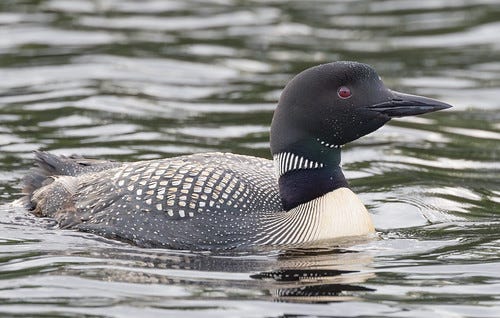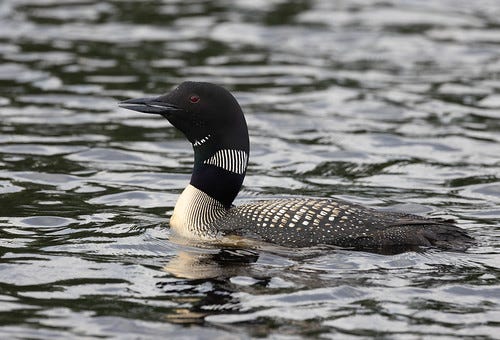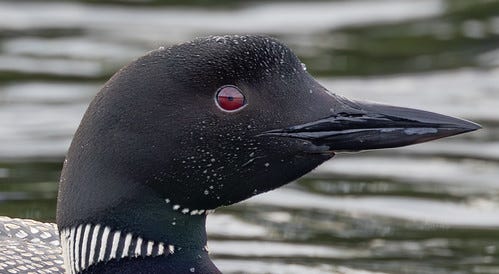(Listen to the radio version here.)
Last weekend one of my friends, Nate Popkin, took Erik Bruhnke and me out in his pontoon boat to observe a pair of loons with their young. The adults were pretty obliging about boats on the lake while the chicks were tiny—on previous jaunts, Nate kept a respectful distance and the family seemed to ignore him. Now, with the chicks a little over four weeks old, the parents seem to be growing more nervous about sharing their lake. Nate turned off the quiet motor when we were still plenty far from the family, and we got some good photos as the family swam toward us for a short distance.
Then one parent started leading the babies off toward the far end of the lake while the other parent approached the boat closer than I’ve ever seen a loon, on and off making the tremolo call.
I of course took plenty of photos and a couple of videos1 while the boat floated there. When Nate started up the motor again, the one parent and the babies were way off toward the far end of the lake, the other parent moving toward them. The one with the chicks apparently instructed them to sit tight and joined the other, now a good distance from us. It was time for us to head back.
Meanwhile, over the years I’ve heard from a lot of pontoon boat owners in Wisconsin who have had pretty much the opposite experience. One of the most serious predators of baby loons are Bald Eagles, which won’t go anywhere near pontoon boats. Apparently some loons on some Wisconsin lakes have figured that out and now bring their chicks to the side of any available pontoon boat when they need to leave them to focus on fishing. The babies sit tight until the parents return with food, and then either swim off with the parents or get left again in the safety of the boat. The owners are apparently too charmed by the trust placed in them, or at least in their boat, to even dream of starting the motor until their babysitting job is over.
Two days after my experience on Nate’s pontoon boat, Nate’s wife Lisa went out on the lake on her paddleboard and stayed at least 100 to 150 yards from the family. Nate writes:
Unexpectedly, the male came up from behind her right next to her and was very agitated. He was very vocal and circling her right next to the board, pumping out his chest and rising out of the water, stomping his feet rapidly up and down on the lake surface near her. She tried to stay still and then paddle very slowly away to the other side and he followed her across the lake—he escorted her away.
I learned in my first ornithology class that adult birds often become increasingly protective of their young as the babies grow. Many disasters that parent birds are utterly helpless to prevent happen early on, which is also when, if tragedy does befall their eggs or tiny nestlings, there is still time to start over that year. By mid-July, parents have not only invested a huge amount of time and effort into their chicks, but they’re also beyond the time of no return as far as re-nesting goes. That could explain why Nate’s adult loons are acting different now than just a week or two ago.
I’m not surprised that his loons haven’t figured out that pontoon boats can provide a safe haven for baby loons in a world over which eagles soar—loons consider humans a threat, too, after all. It’s so cool that some Wisconsin loons have figured out how to exploit eagles’ fear of people. As long as pontoon boaters are consistently trustworthy, baby loons left near pontoon boats during their parents’ fishing jaunts are pretty likely to imitate the behavior when they become parents. But this is the kind of learned behavior that will probably take many generations to become widespread.
The more I learn about birds and the more I watch them up close and personal, the more I appreciate the differences between species and the differences between individuals, the more reasons I have to love them, and the more brightly my incandescent joy glows finding myself on this jewel of a planet so teeming with them.
I can’t embed videos in this blog, but here is the 44-second video with the bird—possibly the male—making four tremolo calls, the third blending into a short wail. And here is the 20-second video with the same bird making six tremolo calls.








Lunes are fascinating birds. When we lived in Juneau I would drive to the glacier for walks/jogs on the glacier moraine trail. A pair of Common Lunes nested on one of the ponds. It was delightful to see the young looking comfortable on the back of the parent!